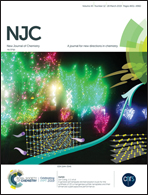Enantioselective Cu-catalyzed 1,4-additions of organozinc and Grignard reagents to enones: exceptional performance of the hydrido-phosphite-ligand BIFOP-H†
Abstract
Enantioselective Cu(I),(II)-(i.e. CuCl, CuCl2, Cu(OTf)2)-catalyzed 1,4-additions of organozinc, i.e. (Et, Me)2Zn, and Grignard reagents, i.e. (Et, Me)MgBr, to chalcone, cyclohexenone and chromone are studied, employing fencholate-based phosphorus ligands, e.g. biphenyl-2,2′-bisfenchyl hydrido phosphite = BIFOP-H. The CuCl·BIFOP-H-catalyzed 1,4-addition of Et2Zn to chalcone yields up to 93% and 99% ee, exceeding established BINOL- and TADDOL-based phosphoramidite ligands. Remarkably, CuCl performs better in 1,4-additions to chalcone (CuCl: 76% ee; Cu(OTf)2: 49% ee; CuCl2: 42% ee) while Cu(OTf)2 performs better in 1,4-additions to cyclohexenone (Cu(OTf)2: 65% ee; CuCl: 20% ee). The computation of the reaction pathway is done for the CuI-catalyzed 1,4-addition to chalcone (CuII will be in situ reduced to CuI by a reagent, TPSS-D3(BJ)/def2-TZVP//B3LYP-D3(BJ)/def2-SVP) for six different model ligands, i.e. (MeO)2P–X (X = H, F, Me, OMe, NMe2 and PMe3). Origins of enantioselectivities are analyzed (M06-2X-D3/def2-TZVP//B3LYP-D3(BJ)/def2-SVP) for transition structures of the 1,4-methylation of chalcone with the Cu·BIFOP-H catalyst and explain the experimentally observed (R)-enantiomer's preference.



 Please wait while we load your content...
Please wait while we load your content...